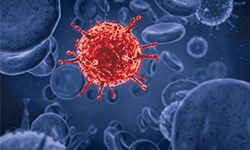Anti-Cancer Agents as Frontline Treatment of MPNs Lead to Higher Probability of Non-Melanoma Skin Cancers
Exposure to ruxolitinib, hydroxyurea, and pipobroman as first-line treatment of Philadelphia-negative myeloproliferative neoplasms alone or in combination with other cytoreductive treatment may increase the probability of patients developing non-melanoma skin cancer, highlighting a need for active dermatological surveillance of these patients, according to findings from the MPN-K study, published in Leukemia.

Exposure to ruxolitinib (Jakafi), hydroxyurea (Hydrea), and pipobroman (Vercyte) as first-line treatment of Philadelphia-negative myeloproliferative neoplasms (MPNs) alone or in combination with other cytoreductive treatment may increase the probability of patients developing non-melanoma skin cancer, highlighting a need for active dermatological surveillance of these patients, according to findings from the MPN-K study (NCT03745378), published inLeukemia.
“MF patients exposed to ruxolitinib alone in first-line monotherapy or in association with other cytoreductive agents may be prone to a higher probability of nonmelanoma skin cancer. Accordingly, for the time being, we recommend active dermatological surveillance before and during these therapies,” wrote the study authors led by Tiziano Barbui, MD, professor of Hematology and scientific director of the Research Foundation at Ospedali Riuniti di Bergamo.
The nested case-control study was conducted to explore the relationship between cytoreductive therapy and second malignancies. The cases included were patients with polycythemia vera (PV), essential thrombocytopenia (ET), or myelofibrosis (MF), who had a secondary cancer. As controls, the study also included patients with MPNs who did not have a second malignancy. Each case was matched to ≤3 controls, which were indexed by sex, age at
MPN diagnosis (±5 years), date of MPN diagnosis (±6 years), and MPN disease duration (±3 years). Cases and controls also had a matching observational period, which allowed for the same probability of achieving the result.
In total, 1881 patients with Philadelphia-negative MPNs were included in the study. In 647 of these patients, a second malignancy was present. The second cancers included carcinoma, non-melanoma skin cancer, hematologic second cancer, and melanoma. Of the patients included, 1234 did not have a second cancer and were evaluated as controls.
A median of 4.5 years (range, 1.5-8.2) was reported from MPN diagnosis to the development of a second malignancy. The type of malignancy that occurred the most frequently was carcinoma (65.8%), which was most commonly of the prostate (n = 121), breast (n = 88), colon-rectum (n = 56), or lung (n = 56). This trend was seen more so with patients who had ET and PV versus patients with MF (P= .079). Cases of other secondary cancers did not differ significantly between the 3 MPNs.
To determine the risk of second cancer after exposure to specific anti-cancer agents, a cancer-specific stratified multivariable analysis was conducted. The results showed that hydroxyurea exposure led to a 2-fold higher probability of having non-melanoma skin cancer (Odds ratio [OR], 2.28; 95% CI, 1.15-4.51). There was also a significantly higher probability observed with pipobroman (OR, 3.74; 95% CI, 1.00-14.01). Patients treated with ruxolitinib had an almost 4-fold higher probability of having non-melanoma skin cancer than non-exposed individuals (OR, 3.87; 95% CI, 1.18-12.75). Combination regimens using these cytoreductive therapies also demonstrated an increased risk of non-melanoma skin cancer (OR, 3.47; 95% CI 1.55-7.75).
Contrarily, a multivariable analysis showed that all 3 drugs had a similar risk of second cancers to patients who had no prior exposure to cytoreductive treatment. For hydroxyurea, the probability of having a second cancer was similar to those who did not receive the agent (OR, 1.06; 95% CI 0.82-1.38 vs OR, 1.14; 95% CI 0.84-1.54, respectively). This finding was consistent across lines of therapy and whether the drug was used as a monotherapy or combination.
For pipobroman, there was a higher risk of second cancer overall (OR, 2.10; 95% CI, 1.09-4.06). The investigators note that there was a higher proportion of patients with second cancers who were exposed to pipobroman than the controls (P= .018).
In patients with second cancer, 58 had been exposed to ruxolitinib in the first line and overall, a significant difference from the controls (P= .033 andP= .048, respectively). Notably, the most impacted groups of patients were those with MF who were treated with ruxolitinib upfront (OR, 4.00; 95% CI, 1.23-13.06), but this trend was also observed regardless of the line of treatment (OR, 1.68; 95% CI, 0.92-3.09).
For combination therapies, more cases than controls were exposed (P= .038). These regimens did not have a higher probability of leading to second cancer in any other malignancy than non-melanoma skin cancer.
Other drugs were also analyzed in the study, including interferon, busulfan (Busulfex), and anagrelide (Agrylin). These agents had no association with the risk of second cancer. Yet, the study authors still cautioned use of busulfan in elderly patients.
Based on these findings, Bardui et al noted that what was observed with hydroxyurea confirms its association with a higher probability of non-melanoma skin cancer reported in prior studies. The investigators suggest close monitoring of patients treated with ruxolitinib in the first-line setting and stress that pipobroman should no longer be used as treatment of patients with MPNs.
The multicenter, international nested-control study included cases from 30 centers. The primary end point of the study was patients with secondary cancers after the diagnosis of a Philadelphia-negative MPN. The secondary end points were the number of patients with a second cancer who were exposed to risk factors, and the number of patients with a second cancer who were in the subgroups exposed to cytoreductive treatment.
Reference:
Bardui T, Ghirardi A, Masciulli A, et al. Second cancer in Philadelphia negative myeloproliferative neoplasms (MPN-K). A nested case-control study.Leukemia33, 19962005 (2019). https://doi.org/10.1038/s41375-019-0487-8









